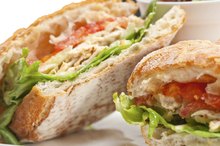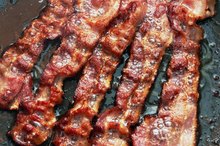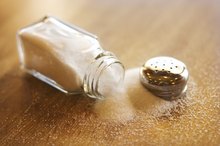What does fact checked mean?
At Healthfully, we strive to deliver objective content that is accurate and up-to-date. Our team periodically reviews articles in order to ensure content quality. The sources cited below consist of evidence from peer-reviewed journals, prominent medical organizations, academic associations, and government data.
- “International Journal of Cancer”; Risk of Colorectal and Other Gastro-intestinal Cancers After Exposure to Nitrate, Nitrite and N-nitroso Compounds: A Follow-up Study; P. Knekt, et al.; March 1999
- “International Journal of Cancer”; Risk of Colorectal and Other Gastro-intestinal Cancers After Exposure to Nitrate, Nitrite and N-nitroso Compounds: A Follow-up Study; P. Knekt, et al.; March 1999
- Centers for Disease Control and Prevention: Leading Causes of Death
The information contained on this site is for informational purposes only, and should not be used as a substitute for the advice of a professional health care provider. Please check with the appropriate physician regarding health questions and concerns. Although we strive to deliver accurate and up-to-date information, no guarantee to that effect is made.
Sodium Nitrite & Cancer
The Centers for Disease Control and Prevention lists cancer as one of the leading causes of death 2. Sodium nitrite is a chemical used to cure meat products and has been implicated as a cancer-causing agent. If you have ever consumed cured meat, you have been exposed to this chemical. Most lunch meat, canned meat and sausage contain sodium nitrite.
Purpose of Sodium Nitrite
Sodium nitrite is a Food and Drug Administration-approved food additive. It is used to cure meats and is a preservative. In the food industry, sodium nitrite is used to give cured meat its pinkish color, increase its shelf life and inhibit the growth of the bacteria that causes botulism. Although sodium nitrite is a naturally-occurring chemical in vegetables, it might increase the risk of developing cancer when used as a food additive.
- Sodium nitrite is a Food and Drug Administration-approved food additive.
- Although sodium nitrite is a naturally-occurring chemical in vegetables, it might increase the risk of developing cancer when used as a food additive.
Large Doses May Increase Cancer Risk
Foods Containing Potassium Nitrate
Learn More
Large portions of processed meats that contain sodium nitrite have been linked to increased incidences of cancer. A study consisting of nearly 10,000 adult males and a 24-year follow-up found a relationship between sodium nitrates from smoked fish and colorectal cancer but not from other cured meats such as smoked sausage and lunch meat.
Small Doses Are Safe
Sodium nitrite does not become toxic or increase risk of cancer in doses up to 10 mg of sodium nitrite per lb. of body weight, according to the FDA. This translates to an intake of 19 lbs. of cured meat for a 150-lb. individual. The FDA considers 200 parts per million, or ppm, of sodium nitrite added to food as safe; this is equivalent to about 1 lb. of sodium nitrite additive per 5,000 lbs. of cured meat.
- Sodium nitrite does not become toxic or increase risk of cancer in doses up to 10 mg of sodium nitrite per lb.
- The FDA considers 200 parts per million, or ppm, of sodium nitrite added to food as safe; this is equivalent to about 1 lb.
Uncured Meats are Available
Sodium Nitrate Consumption During Pregnancy
Learn More
Overall, small amounts of cured meats containing sodium nitrite are not likely to cause cancer. If you want to avoid sodium nitrite altogether, many natural food supermarkets offer meat products that are nitrite-free. These products are often labeled uncured and will not have sodium nitrite listed as an ingredient.
Related Articles
References
- “International Journal of Cancer”; Risk of Colorectal and Other Gastro-intestinal Cancers After Exposure to Nitrate, Nitrite and N-nitroso Compounds: A Follow-up Study; P. Knekt, et al.; March 1999
- Centers for Disease Control and Prevention: Leading Causes of Death
- U.S. Food & Drug Administration. CFR - Code of Federal Regulations Title 21. Updated April 1, 2018.
- National Institutes of Health. Lower-sodium foods: shopping list. Updated August 22, 2020.
- Clemson Cooperative Extension. HGIC 4061 Nutrient Claims on Food Labels: Extension: Clemson University: South Carolina. http://www.clemson.edu/extension/hgic/food/nutrition/nutrition/dietary_guide/hgic4061.html.
- U.S. Food and Drug Administration. Consumer Information on Reducing Sodium Intake. http://www.fda.gov/Food/IngredientsPackagingLabeling/FoodAdditivesIngredients/ucm253316.htm.
- U. S. Food and Drug Administration. Guidance for Industry: A Food Labeling Guide (9. Appendix A: Definitions of Nutrient Content Claims). http://www.fda.gov/Food/GuidanceRegulation/GuidanceDocumentsRegulatoryInformation/LabelingNutrition/ucm064911.htm
- USDA. Information on Sodium/Salt. https://snaped.fns.usda.gov/nutrition-education-materials/lifestyle-nutrition/myplate-dietary-guidelines-and-general-nutrition
Writer Bio
A registered dietitian and licensed dietitian/nutritionist, Brandy Williams began writing in 2007. Her publications can be found in peer-reviewed journals such as the "American Journal of Lifestyle Medicine" and "Public Health Nutrition." Williams holds a Master of Science in human nutrition and food from Louisiana State University.









